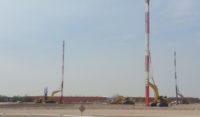After almost two years focused primarily on-site preparation, the $800 million replacement of Salt Lake City’s only wastewater treatment or water reclamation facility (WRF) is shifting to the major construction phase as the project moves toward a January 2025 completion date. The largest project undertaken in the public utility’s history and the second largest in the city behind the multi-billion replacement of the Salt Lake City International Airport is moving ahead in the face of supply issues that have raised costs and caused uncertainty.
“We’ve been fortunate that we haven’t taxed the concrete supply in this area yet. Our challenge is going to be starting next month, and for the next 16 months, we’re going to be pouring about 7,000 cu yds of concrete a month. The package is for 80,000 cu yds.” says Steve Van Loan, project director for the joint venture team of Arizona-based Sundt Construction and PCL Construction. “We’ve had issues getting stainless steel, FDPE and FRP and a real challenge getting the electrical gear we need, and we’ve yet to see the full impact from the rebuilding that is going to have to happen in Florida after the hurricanes. A lot of raw material is going to have to go into rebuilding and it is going to strain an already strained system.”
Sundt/PCL JV holds the CMGC contract for construction of the facility designed by AECOM of Dallas, Texas.
Multiple Factors Drove Replacement
The new WRF is being built on a 110-acre site directly adjacent to the current facility which will continue operating, treating an average of 35 million gallons a day from the capitol city of 200,000 people. New water quality regulations issued in 2015 as well as the age of the facility that is approaching 60 years of operation pushed the public utility to look at options years before the new regulations were issued, says Laura Briefer, director of Salt Lake City Public Utilities.
“We looked at retrofitting and upgrades, but we went with complete replacement because we also wanted to harden the operations against things like earthquakes and flooding that weren’t considered when the current facility was built,” Briefer says.
While designed for future expansion, the completed plant will treat the same amount of wastewater. “Even with the increases in population recently, overall water use has been decreasing thanks to conservation efforts,” Briefer says. “We have more aggressive conservation goals in the years ahead and this new facility should meet our needs to about 2060.”
Another improvement according to Briefer is the elimination of the open-air drying beds for the bio-solids that caused odor problems. “We had odor control in mind as a goal early on but in our meetings with the community it was really something they wanted and it became a higher priority,” she says.
The new facility will use mechanical dewatering in an enclosed building and all air released will be monitored for odor control. A temporary mechanical dewatering facility has been in use since 2020. Grant Davies, project manager for AECOM, says at the suggestion of some of the facility operators, two of the four presses to be used in the new WRF were installed in the temporary building allowing workers to be trained on the new equipment before the new plant is completed.
Getting the Site Right
Most of the new facility is being built on the site previously occupied by the bio-solids drying beds. Due to poor soil conditions and a high water table the soil needed to be stabilized before construction could begin.
“We made the decision in early 2020 to preload the site to dewater it rather than place everything on piles. Piles would have had to be over 200 ft long,” Van Loan says.
The team placed 43,870, 135 ft. long wick drains around the site then loaded the area with 800,000 tons of soil forcing water up and out through the wick drains.
“We left the soil in place for about 10 months," Van Loan says. "At the peak, we were removing 200 to 300 gallons of water a minute. We achieved almost six feet of settlement at the north end of the site and about five feet at the south end. Once we got the ‘OK’ from the geotechnical engineers we started removing the soil and that took about eight months. The wick drains will stay in place, and we have a dewatering system that will continue operating.”
According to Briefer and Van Loan, preloading the site rather than driving piles saved the project more than $40 million. The soil has been stockpiled to be used later in the project as back-fill, but the majority will be taken by the Utah Department of Transportation to be used on road projects.
Finding ways to reduce costs amid rising prices and supply constraints has been a constant challenge for the team.
Davies said the team has gone through multiple value engineering exercises and managed to cut around $130 million so far. In 2020 the public utility received a federal WIFIA loan of $348.6 million. The remainder of the project cost will be covered by rate increases instituted over the last six years says Jason Brown, chief engineer for Salt Lake City Public Utilities. “We’ll also do some bonding. But, that WIFIA loan will save us about $60 million in interest payments,” he says.
Despite the challenges, Davies says the project is on track to meet the Platinum-level Envision certification.
Brown says while this is the first CMGC project the utility has done he’s pleased with the process.
“Having the contractor come in with ways to save money when we are seeing cost escalation has been one of the best things we could have done,” he adds.




Post a comment to this article
Report Abusive Comment